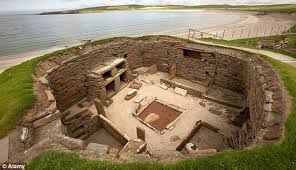The now-archaeological-site, once-village of Skara Brae on the coast of the Orkney Islands of Scotland was subjected to huge storm during the late Neolithic period – burying its structures deep under a layer of sand, which acted as a preservative for the buildings and their contents for multiple millennia – four to be exact. The protective quality of the sand kept the structures and everything within them shockingly intact since around 3200 – 2200 BC. The very gradual drift of sand after the storm embedded the village of Skara Brae into the earth, making it uninhabitable for the original Stone Age villagers.
So, was it the storm alone that drove away the native inhabitants of Skara Brae? Not exactly. “The fall” of Skara Brae as a society and abandonment of it as a geographical location was actually due to long term erosion along the coast and changes in the society’s needs, not only the single event of the storm (though the storm did intensify and speed up erosion) (Orkneyjar). Even before the major storm, island conditions such as the spray of salt water and sand probably made the land virtually unworkable and unfit for food production. While that may have been okay for a while, eventually people moved away to more productive areas where they could get a more constant supply of food. The few who remained most likely finished out their lives in Skara Brae without repopulating the area.
But how was Skara Brae found if it was under a massive layer of sand? Well, another natural disaster occurred 4,000 year later in 1850, a violent storm “whose winds and extremely high tides” ripped up the earth and grass from Skerrabra – a large mound on the island (Orkneyjar). Foundations, walls, and remains of stone buildings and houses were discovered underneath the mound, to the surprise of those living there at the time. But 75 years later, in 1925, another storm came around, damaging the excavated ancient structures. Accordingly, preservation efforts were put in place through the construction of a sea wall (an embankment erected to prevent the sea from encroaching on an area of land), which actually exposed even more stone buildings! During this time period, most archaeologists believed the settlement to be from the Iron Age – around 500 BC. But finally, as we know now thanks to radiocarbon dating in the 1970s, the buildings were proved to be from the late Neolithic period and inhabited for 600 years.
While so far storms seem to have acted in an oddly beneficial way for the archaeological preservation and exposure of Skara Brae’s long-hidden cultural artifacts and features, an increase in erosion rates have posed an environmental and archaeological threat. Steps are being taken to minimize the effects of this accelerated erosion due to natural and human causes.
For Further Reading on Skara Brae:
http://ngm.nationalgeographic.com/2014/08/neolithic-orkney/smith-text
http://www.ancient.eu/Skara_Brae/
References:
http://www.orkneyjar.com/history/skarabrae/
http://www.culture24.org.uk/am15888
http://www.dailymail.co.uk/home/moslive/article-1298318/Ten-greatest-British-heritage-sites.html



Weather and other environmental factors truly can help or hinder the process of discovering ancient sites like Skara Brae. Fortunately, the effects of several natural disasters led to an amazing find which has provided new insight into the history of Skara Brae and the lives of its native people. Preserving ancient sites such as this one presents an opportunity for archaeologists to study the artifacts, infer how people survived within the region, and examine the development of cultural practices dating back thousands of years.
Similarly, in Syria, a ninety-foot mound dating back to 3500 BC, dubbed the Tell Mozan, has remained intact despite the country’s current civil unrest. The Tell Mozan and Skara Brae are two archaeological sites facing external pressures that threaten to destroy its deep cultural history and significance. Thankfully, much information has been gathered from the sites despite adverse environmental and human effects.
More information about the Tell Mozan:
http://news.nationalgeographic.com/2015/06/150604-urkesh-syria-mozan-buccellati-archaeology/
This site is a perfect example of how archaeologists can speak to climate change. Yesterday’s disasters created todays habitable zones. Tomorrow’s disasters threaten those same places. We need to be willing to change not only how but where we live if we are going to survive. Our ancestors did just that but they didn’t live and work in the same sort of political and economic system that we do today. Skara Brae teaches us to think twice about our connections to place. We may lose a major American city to disaster in your lifetime. How will we deal with that?